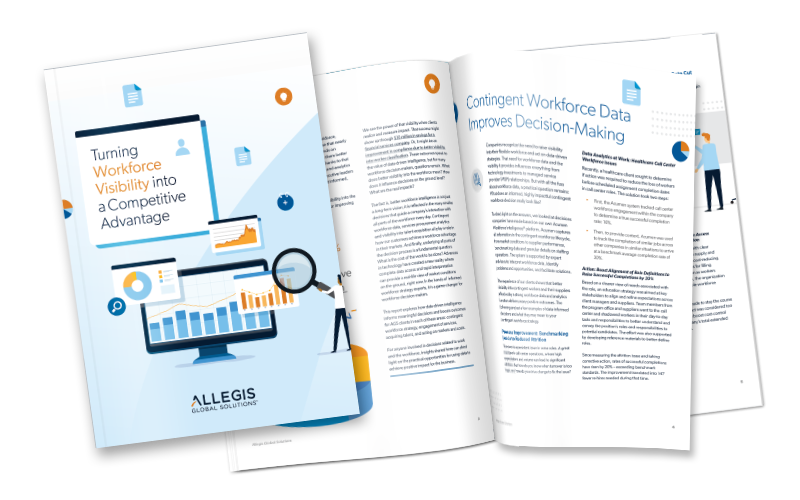Recruitment Technology for a Skills-Based Workforce
Technology is the cornerstone for success in nearly every aspect of managing today’s global workforce. Building strategies for the constantly shifting workforce requires a nimble, knowledgeable and technologically advanced leader to stay competitive and ensure work gets done. From hiring and SOW management to diversity and inclusion initiatives, having the right recruitment technology is a business imperative – especially as the industry moves towards a skills-based workforce approach.
To achieve these goals and compete in a global market, businesses need to investigate and deploy proven, innovative recruitment technologies to:
- Access and view your entire available workforce in one place, regardless of category
- Stay informed of the most up-to-date market trends, pay rates and salaries
- Identify available skills and assess these using non-biased machine learning-enabled assessment tools
- Create a more diverse, inclusive and equitable workforce across your entire enterprise
What is Skills-Based Hiring and Why It Matters for Your Business
Advanced recruitment technologies elevate workforce management every step of the way. Starting with hiring and sourcing practices, technologies provide faster access to talent by leveraging machine learning to view skilled workers and open your search to previously untapped pools of talent.
Recruitment technologies also analyse and predict the success of a candidate based on their skill sets and help decipher the strongest skills across worker types. These features – which are seeing positive results for companies around the globe – set your organisation up for a more skills-based workforce strategy that not only keeps you competitive in the market, but also sets you up to gain market share and grow.
But what exactly is skills-based hiring? It is how you deploy the right skills against the needs of the business at the right time. It is a change in recruitment mindset towards putting skills to work for the benefit of the company – looking at what a candidate can do for you and what they offer, versus more traditional requirements such as past job titles and degree level. This expands your hiring and placement options to people who may fill the needs of the business but may have otherwise been weeded out by less relevant requirements that may not have any bearing on their ability to do the work.
Studies show that businesses that engage the market through skills-based hiring have a 91.2% higher retention rate, an 89.9% reduction in cost-to-hire, 91.4% reduction in time to hire and 91.1% increase in diversity.
Using advanced technologies that can review, analyse and categorise candidates based on their skills is often the first step to skills-based hiring. Traditional silos of where and how we acquire talent are no longer the ideal, and many companies find that they need to innovate to ensure work is getting done, their overall company objectives are being achieved and that they remain competitive.
In addition to enabling the benefits of a skills-based approach, properly supporting your corporate workforce strategy with recruitment technology will address several talent acquisition challenges, such as workforce visibility, integration, access to data and automation.
Recruitment Technology Enables Your Workforce Strategy
Workforce technology touches each step of managing the modern global labor force, including:
- Candidate relationship management (CRM) - job search, applications, scheduling interviews, etc.
- Applicant tracking system (ATS)
- Talent management - talent search, efficiency, inclusivity, analysis, worker status, etc.
- Learning and development
Workforce technology should provide the tools your organization need to ensure your work gets done.
Building a workforce strategy that spans a global workforce can be a daunting task. However, today’s technology – paired with the support of expert advisors – can build a roadmap that makes creating, examining and deploying your workforce strategy manageable and successful. Advances in computing and data collection make gaining a realistic and true view of your current workforce – and what may be missing from it – possible. This is the foundation for developing your strategy.
Once you have a roadmap to what you have and what work needs to be done, you can utilise recruitment technology to analyse the skills required and even help build job descriptions. For example, generative artificial intelligence (AI) tools, such as ChatGPT, are helping some companies create more equitable job descriptions by taking a passionless look at the work to be done and fill in what’s required without biases that can hinder skills-based sourcing.
Businesses have been in the war for talent for years now with no real end in sight. Though we are working in a time where technology is a standard part of the recruitment process, advances in computing, such as machine learning (ML) and generative AI, are building a greater impact on recruitment technology capabilities. These advances and expansions in what our technology can do are blurring the boundaries between technology providers and services providers. Now, your service providers need to be tech savvy and have platforms that integrate these tools to stay ahead in the market and make your workforce strategy a reality.
Today’s top service providers rely on a myriad of products that have evolved from various technologies into talent intelligence platforms. The potential of these platforms bring recruitment into a new, more intuitive and automated stage. Very simply, a smart technology platform brings a great workforce strategy to life; however, building a digital ecosystem for a lasting workforce advantage is a challenge due to the historic separation between traditional workforce channels.
Organisations need full visibility into their employed and extended workforce and a gateway to complementary technologies. They need to match resources to tasks, regardless of workforce category, by using data to enable objective, evidence-based hiring decisions.
Building the Right Recruitment Technology Ecosystem – An Intelligent Workforce Platform
With so much at stake and budgets tighter than ever, every workforce decision-maker faces a clear challenge: how do you get the technology strategy right? We should always start the conversation about the problem we're trying to solve, such as:
- Getting meaningful data and insights as well as benchmarking
- Diversity, equity and inclusion (DEI) goals
- Improved candidate engagement
- Access to more talent
- Automating repetitive processes
When building out your technology stack, it is also important to look at the compatibility of new tools with your current technological resources, and expandability for future use and continued building towards future needs.
AGS’ Acumen® Intelligent Workforce Platform vision was created for this purpose. By combining existing technology tools, both proprietary and partner, AGS provides a scalable and agile digital ecosystem to address and solve the problems faced by workforce leaders.
The Acumen Intelligent Workforce Platform is therefore a game-changer for organizations looking to understand and optimize their workforce. The platform provides organizations with the tools they need to stay competitive in today's job market and enables faster adoption of new products. Robust workforce scenario planning and forecasting, candidate engagement, sourcing, matching and evaluation are at the core of the Intelligent Workforce Platform.
When examining the right platform for you to manage your organisation’s workforce, there are certain capabilities that you should look for, such as:
- Combines internal and extended workforce recruitment data with intelligent workforce analytics to enable the deconstruction of work and strategic planning of the hiring mix that focus on business outcomes.
- Integrates with a range of products directly into the ecosystem, with minimal client integration points.
- Ensures data centricity and automation to provide an adaptable recruitment solutions where you can benefit from future technological innovations faster.
- Enables sourcing and matching elevated by automation and ML algorithms to match across all talent sources intelligently, including internal, external, contingent, freelance and SOW resources.
Although new advances in technology are exciting and generative AI advancements are dominating headlines, what really matters is that the technology works for you and your clients. Workforce leaders turn to managed service providers (MSP) and recruitment process outsourcing (RPO) partners to gain expert assistance in solving the following strategic challenges that can be addressed with an Intelligent Workforce Platform:
- Workforce visibility
- Integration
- Access to talent
- Access to data
- Automation
Visibility of the Entire Workforce in One Place
Clients’ workforce data is often fragmented due to it being recorded in separate applications (human resources information system (HRIS), ATS or vendor management systems (VMS) or managed by separate MSP, procurement solutions or RPO providers. When the information is fragmented, it is incredibly difficult to get a clear and concise picture of your client’s entire workforce.
With Acumen Intelligent Workforce Platform, we can securely combine all this data to provide a complete view of the entire workforce – both employed and extended workforces, as well as freelancers, gig workers and external talent. This helps ensure that workforce planning is focused on the best way to get work done and opens up the ability to use a range of worker types based on the best needs of the organisation.
Access to reliable data can also help you identify what you're spending on a particular skill set and if you're able to obtain those same skills at a better price or faster availability. This could mean considering hiring a contingent worker instead of a consultant, or perhaps researching better rates based on locations and skills. Often you can get the same work done quicker from a different, lower cost location.
Integrating Additional Technologies
Typically, client-owned recruitment technology solutions are static and centered around the ATS or VMS. In many cases, a CRM is in place as well. But due to internal competition for technology resources, projects to integrate these tools or add additional point solutions are often deprioritised.
Using Acumen, we can solve this problem. By maintaining a minimum integration to a client environment (i.e., direct to their ATS), we can enable a range of technologies within the Acumen ecosystem. We are able to manage the future integration requirements and can swiftly add more tools to the client tech stack when needed. This keeps the tech stack updated and ensures that our clients can access the latest and most appropriate tools without navigating their internal request process.
Further, we can add onto the Acumen platform, without heavy disruption to the client’s internal systems, to provide additional benefits as technologies advance.
Access to External Talent Pools
Clients are often largely limited to the capabilities of their internal ATS/VMS and have less access to external talent pools. This is a challenge when trying to expand and find the best talent for the skills needed. Through recruitment tools, such as Acumen, workforce management leaders can provide clients with access to a range of talent pools for full-time employment (FTE) and the contingent workforce.
In addition to finding talent that have the best skills to get the work done, access to a larger talent pool can help you find people that meet your DEI goals, may reside anywhere on the globe and are uniquely qualified to meet your business needs. In addition to greater access to new pools of workers, Acumen also pulls from the high-quality curated data accumulated from all Allegis Group companies.
Market Insights and Benchmarking Data
Running reports from ATS or VMS systems are useful in providing access to completed-jobs, cost-per-hire and time-to-fill data. However, those systems alone lack intelligence for the extended workforce. They also do not have the ability to benchmark activity against other companies. These shortcomings mean that the information you are able to learn from this data is extremely limited.
Industry leaders are moving towards more robust Intelligent Workforce Platforms to provide reliable and thorough data that covers the entire workforce. Acumen, the AGS Intelligent Workforce Platform, provides these insights through a market-leading analytics tool that combines data from all MSP programmes and an ever-increasing number of RPO programmes. In addition, our partnerships with Brightfield TDX and Lightcast provide additional market insights and labour market data to provide more meaningful reports for clients.
In addition to filling more immediate needs for getting work done, the Acumen Intelligent Workforce Platform can supply the analytics of past trends and for the external market data to aide you in properly planning for future hiring. This means you are talent pooling in advance, preparing now to meet inevitable demands.
Enabling Automation
Automation enhances and streamlines processes, enables new capabilities and improves efficiency. However, it is often one of the most overlooked opportunities. Many people think that automation equals robotics and that they will be replaced at their jobs, but that is not typically the case. Automation uses technology to perform more mundane, repetitive jobs, freeing up the worker to perform higher-value tasks. This can allow your workers to be more effective and efficient in their jobs.
It’s also something that in most cases is simple to get started. Anywhere you are paying people to run manual processes has the potential to be automated. This doesn’t always mean headcount reduction, however that is also an option, when you evaluate the work to be done and the skills required.
Generative AI and Its Impact on Recruitment
Publicity around generative AI technology has exploded recently particularly with the latest evolution of ChatGPT. This is not new technology. However, the chat capability that has made it much more accessible to the average user has accelerated adoption and the myriad of ways it can be applied to business needs. Generative AI can deliver humanlike text and has a wide range of applications, including language translation, language modelling and content generation.
We are in the early stages of generative AI and foresee a great number of advances in the future. Yet the transformative nature of the technology for recruitment is already apparent – generative AI is being used to create job descriptions, CVs, biographies and even automated online communications with candidates. There are also systems that are reading CVs in order to help analyze if the CV fits the skills required for the position.
ChatGPT and generative AI have opened faster and easier access to AI for recruitment. A wide range of use cases are now within touching distance for recruiters, hiring managers and candidates.
It is crucial to recognize that with many technologies, and AI is not an exception, there are platforms built for enterprises vs. public use. The security measures, functionality and capabilities for wider use are imperative to consider when deploying newer technological resources.
Hiring for Potential
Solving the skills shortage is not going to be achieved by doubling down on existing processes. Today’s business needs and the pace of modern work require using technology and recruitment tools to cast the net into different talent pools and look at a more inclusive group of candidates. These may include candidates that possess strong uniquely human traits such as problem solving, sales, perseverance, leadership and relationship skills but have not been afforded the opportunities to gather the job-related skills. This could be due to socioeconomic backgrounds, time out of the workforce while raising children or even people displaced and starting life in a new country.
These are people who are seldom given opportunities because their CV doesn't include a university qualification or work experience with names of blue-chip organisations. With that said, it is often difficult to understand their unique potential and how it can translate into career opportunities and developing roadmaps for this potential to bring them in and provide a career path. The impact on your company as well as these workers could be immeasurable.
By analysing the various skills of the candidates instead of checking off particular requirements, non-biased assessment technology helps you find these workers so you can invest in future talent while benefiting from lower cost per hire, improved diversity and employee loyalty.
What Does This Mean for the Future of Recruiting?
With the rapid development and advancement of technology, we can no longer have a one-dimensional view of the processes designed to filter out candidates until we choose the last person standing. Our traditional sourcing approaches are still relevant, and there will always be a need to home in on specific skills and capabilities. However, we now need to engage technological sources that open the playing field and make us more competitive in the market.
As we elevate our processes, we will need to combine traditional know-how with utilising tools that exclude a CV from the equation. We will need a recruitment technology stack that is adaptable to match talent on metrics that are not housed exclusively in the CV. In fact, we need the ability to completely exclude the CV in order to truly open doors to marginalised talent.
These platforms will need to analyse behavioural skills and other psychometric tools to assess potential in candidates and open up career opportunities to those whose demographic or life journeys have precluded them from the opportunity to build an attractive CV. Intelligent Workforce Platforms that are able to find those gems, who are stuck in jobs that don’t let them fulfil their potential, will have an incredible advantage to companies looking for great talent and people in whom they can build corporate loyalty. Companies will be able to identify the pathways into the organisation where these new hires can enter and then build out a career development program through learning and development, mentoring and apprenticeships.
Finally, including an Intelligent Workforce Platform into your overall technology stack ensures that skills-matching, workforce visibility and hiring for potential become a long-term focus and not just a project. By deploying assessment tools that look beyond the traditional CV and rank candidates fairly using a combination of demonstrable skills and experience along with performance forecasts, you are positioning your company for finding workers for decades to come, from far-reaching pools of talent. Incorporating these tools expands your talent ecosystem in a way that trends are showing will be the next evolution in recruitment.





